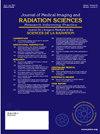Comparison of image-guidance in proton and photon radiation therapy: Preliminary clinical experience
IF 1.3
Q3 RADIOLOGY, NUCLEAR MEDICINE & MEDICAL IMAGING
Journal of Medical Imaging and Radiation Sciences
Pub Date : 2024-10-01
DOI:10.1016/j.jmir.2024.101541
引用次数: 0
Abstract
Proton therapy (PT) has a unique depth dose profile (Bragg peak), where it is more superior than IMRT in target volume dose coverage and lower OARs doses. Proton is more sensitive to density and contour changes along the traversed beam as these would affect Bragg peak dose deposition and overall dosimetry. Geometrical uncertainties are crucial in affecting dosimetry for both IMRT and PT, however more detrimental for the latter as they affect proton's penetration range. To minimize these uncertainties, image-guidance in PT is essential. Hence, we aim to compare PT and IMRT image-guidance based on our early PT clinical experiences. From June 2023 to January 2024, 74 patients (7 brain, 32 head-and-neck (HN), 10 thorax-abdo, 18 prostate and 7 paediatrics) received PT in our centre. PT clinical imaging experiences were compared with departmental IMRT imaging protocols. IMRT (orthogonal kV and/or CBCT) used bone-based and soft-tissue-based registration. Soft-tissue-based registration is inevitable in PT (CBCT) due to additional need to focus on overall contours. Thus, low-dose contours acting as beam shape surrogates are also implemented in PT image registration for evaluation of overall contour match along individual beam path. In brain and HN cases, matching criteria and correction strategies are similar for IMRT and PT. However, additional attention is given to shoulder positions, sinuses filling and contour variations in PT HN image verification. Prostate and liver cases used CBCT matching for both treatment techniques. Furthermore in PT, additional real-time fiducial tracking is utilised to reduce intra-fractional motion. Image-guidance enables accurate target-alignment and monitoring of anatomical/contour changes to trigger adaptive replanning if required. To achieve proton's superior robust plan, surrounding anatomical structures must constantly be in the same position as planned in addition to precise target-alignment. Thus, 3D-volumetric imaging and 6D correction strategies are highly relevant in PT compared to IMRT.
质子和光子放射治疗中图像引导的比较:初步临床经验
质子疗法(PT)具有独特的深度剂量曲线(布拉格峰),在靶体积剂量覆盖率和较低 OARs 剂量方面比 IMRT 更有优势。质子对穿越射束沿线的密度和轮廓变化更为敏感,因为这些会影响布拉格峰剂量沉积和总体剂量测定。几何不确定性是影响 IMRT 和 PT 剂量测量的关键因素,但对后者更为不利,因为它们会影响质子的穿透范围。为了尽量减少这些不确定性,PT 的图像引导至关重要。因此,我们根据早期 PT 的临床经验,对 PT 和 IMRT 的图像引导进行了比较。自2023年6月至2024年1月,74名患者(7名脑部患者、32名头颈部患者、10名胸部患者、18名前列腺患者和7名儿科患者)在我中心接受了PT治疗。PT 临床成像经验与科室 IMRT 成像方案进行了比较。IMRT(正交 kV 和/或 CBCT)使用基于骨骼和基于软组织的配准。在 PT(CBCT)中,由于额外需要关注整体轮廓,基于软组织的配准是不可避免的。因此,在 PT 图像配准中也采用了低剂量轮廓作为光束形状代理,以评估单个光束路径的整体轮廓匹配情况。在脑部和 HN 病例中,IMRT 和 PT 的匹配标准和校正策略相似。不过,在 PT HN 图像验证中,肩部位置、鼻窦填充和轮廓变化受到了额外关注。前列腺和肝脏病例在两种治疗技术中都使用了 CBCT 匹配。此外,在 PT 中,还利用了额外的实时靶标跟踪来减少点内运动。图像引导可实现精确的目标对准,并监测解剖/轮廓变化,以便在需要时触发自适应重新扫描。为了实现质子的卓越稳健计划,除了精确对准目标外,周围的解剖结构必须始终保持在计划的相同位置。因此,与 IMRT 相比,三维容积成像和 6D 校正策略在 PT 中非常重要。
本文章由计算机程序翻译,如有差异,请以英文原文为准。
求助全文
约1分钟内获得全文
求助全文
来源期刊

Journal of Medical Imaging and Radiation Sciences
RADIOLOGY, NUCLEAR MEDICINE & MEDICAL IMAGING-
CiteScore
2.30
自引率
11.10%
发文量
231
审稿时长
53 days
期刊介绍:
Journal of Medical Imaging and Radiation Sciences is the official peer-reviewed journal of the Canadian Association of Medical Radiation Technologists. This journal is published four times a year and is circulated to approximately 11,000 medical radiation technologists, libraries and radiology departments throughout Canada, the United States and overseas. The Journal publishes articles on recent research, new technology and techniques, professional practices, technologists viewpoints as well as relevant book reviews.
 求助内容:
求助内容: 应助结果提醒方式:
应助结果提醒方式:


